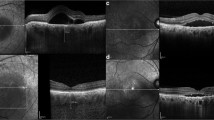Abstract
To determine changes in choroidal thickness in patients with central serous chorioretinopathy (CSCR) during the first 3 months after initial diagnosis and assess variable therapeutic interventions via enhanced depth imaging spectral-domain optical coherence tomography (EDI-OCT). In this prospective study, choroidal thickness was measured via EDI-OCT both in the affected and fellow eyes of 10 patients with CSCR at the fovea, as well as at 500 and 1,000 μm both temporal and nasal from the centre of the fovea and at the leakage point (if present), visualised via fluorescein angiography. Follow-up measurements were performed after 2–3 weeks, 6–8 weeks and 3 months. Seven of the 10 patients received additional systemic therapy with oral acetazolamide. A control group of eight healthy subjects was recruited to determine normal choroidal thickness in healthy eyes. The mean age of the 10 patients (9 male, 1 female) in the CSCR group was 42.1 (±9.3) years. The choroid in the affected eyes was significantly thickened at baseline compared to fellow eyes and the eyes of healthy subjects. The choroid in the fellow eyes also revealed a slight thickening at baseline compared to normal eyes. During the 3 month follow-up period, the choroidal thickness of the affected eyes showed a highly significant decrease, but did not reach normal levels. Minor changes could also be observed in the fellow eyes but did not reach statistical significance. In patients with CSCR, the average choroidal thickness not only demonstrated a significant thickening at baseline, but also showed a marked decrease after 3 months, yet not reaching normal levels. Our data indicate that after 3 months, normalisation of choroidal thickness is not yet completed.



Similar content being viewed by others
References
Ross A, Ross AH, Mohamed Q (2011) Review and update of central serous chorioretinopathy. Curr Opin Ophthalmol 22:166–173
Maruko I, Iida T, Sugano Y, Ojima A, Sekiryu T (2011) Subfoveal choroidal thickness in fellow eyes of patients with central serous chorioretinopathy. Retina 31:1603–1608
Haimovici R, Koh S, Gagnon DR, Lehrfeld T, Wellik S (2004) Risk factors for central serous chorioretinopathy: a case-control study. Ophthalmology 111:244–249
Prunte C (1995) Indocyanine green angiographic findings in central serous chorioretinopathy. Int Ophthalmol 19:77–82
van Velthoven ME, Verbraak FD, Garcia PM, Schlingemann RO, Rosen RB, de Smet MD (2005) Evaluation of central serous retinopathy with en face optical coherence tomography. Br J Ophthalmol 89:1483–1488
Maruko I, Iida T, Sugano Y, Ojima A, Ogasawara M, Spaide RF (2010) Subfoveal choroidal thickness after treatment of central serous chorioretinopathy. Ophthalmology 117:1792–1799
Pikkel J, Beiran I, Ophir A, Miller B (2002) Acetazolamide for central serous retinopathy. Ophthalmology 109:1723–1725
Margolis R, Spaide RF (2009) A pilot study of enhanced depth imaging optical coherence tomography of the choroid in normal eyes. Am J Ophthalmol 147:811–815
Spaide RF, Koizumi H, Pozzoni MC (2008) Enhanced depth imaging spectral-domain optical coherence tomography. Am J Ophthalmol 146:496–500
Imamura Y, Fujiwara T, Margolis R, Spaide RF (2009) Enhanced depth imaging optical coherence tomography of the choroid in central serous chorioretinopathy. Retina 29:1469–1473
Fujiwara T, Imamura Y, Margolis R, Slakter JS, Spaide RF (2009) Enhanced depth imaging optical coherence tomography of the choroid in highly myopic eyes. Am J Ophthalmol 148:445–450
Spaide RF (2009) Enhanced depth imaging optical coherence tomography of retinal pigment epithelial detachment in age-related macular degeneration. Am J Ophthalmol 147:644–652
Spaide RF (2009) Age-related choroidal atrophy. Am J Ophthalmol 147:801–810
Imamura Y, Fujiwara T, Spaide RF (2010) Frequency of glaucoma in central serous chorioretinopathy: a case-control study. Retina 30:267–270
Chhablani J, Barteselli G, Wang H, El-Emam S, Kozak I, Doede AL, Bartsch DU, Cheng L, Freeman WR (2012) Repeatability and reproducibility of manual choroidal volume measurements using enhanced depth imaging optical coherence tomography. Invest Ophthalmol Vis Sci 53:2274–2280
Gass JD (1967) Pathogenesis of disciform detachment of the neuroepithelium. Am J Ophthalmol 63:139
Iida T, Kishi S, Hagimura N, Shimizu K (1999) Persistent and bilateral choroidal vascular abnormalities in central serous chorioretinopathy. Retina 19:508–512
Spaide RF, Goldbaum M, Wong DW, Tang KC, Iida T (2003) Serous detachment of the retina. Retina 23:820–846
Piccolino FC, Borgia L (1994) Central serous chorioretinopathy and indocyanine green angiography. Retina 14:231–242
Negi A, Marmor MF (1984) Experimental serous retinal detachment and focal pigment epithelial damage. Arch Ophthalmol 102:445–449
Cox SN, Hay E, Bird AC (1988) Treatment of chronic macular edema with acetazolamide. Arch Ophthalmol 106:1190–1195
Tripathi RC, Fekrat S, Tripathi BJ, Ernest JT (1991) A direct correlation of the resolution of pseudophakic cystoid macular edema with acetazolamide therapy. Ann Ophthalmol 23:127–129
Wolfensberger TJ (1999) The role of carbonic anhydrase inhibitors in the management of macular edema. Doc Ophthalmol 97:387–397
Conflict of interest
The authors declare that they have no conflict of interest.
Author information
Authors and Affiliations
Corresponding author
Rights and permissions
About this article
Cite this article
Brandl, C., Helbig, H. & Gamulescu, M.A. Choroidal thickness measurements during central serous chorioretinopathy treatment. Int Ophthalmol 34, 7–13 (2014). https://doi.org/10.1007/s10792-013-9774-y
Received:
Accepted:
Published:
Issue Date:
DOI: https://doi.org/10.1007/s10792-013-9774-y




